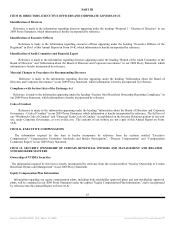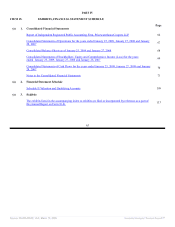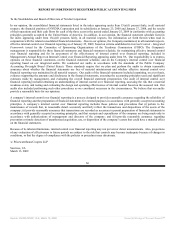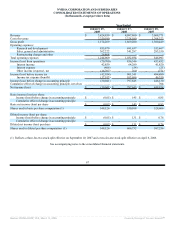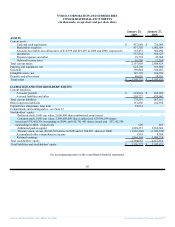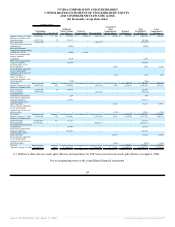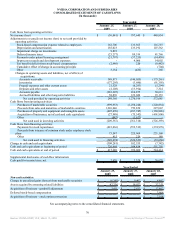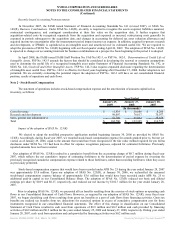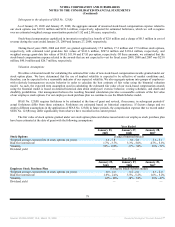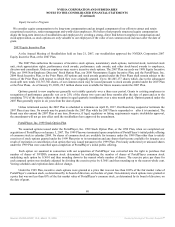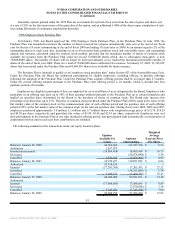NVIDIA 2009 Annual Report Download - page 87
Download and view the complete annual report
Please find page 87 of the 2009 NVIDIA annual report below. You can navigate through the pages in the report by either clicking on the pages listed below, or by using the keyword search tool below to find specific information within the annual report.
NVIDIA CORPORATION AND SUBSIDIARIES
NOTES TO THE CONSOLIDATED FINANCIAL STATEMENTS
(Continued)
Revenue Recognition
Product Revenue
We recognize revenue from product sales when persuasive evidence of an arrangement exists, the product has been delivered,
the price is fixed and determinable, and collection is reasonably assured. For most sales, we use a binding purchase order and in
certain cases we use a contractual agreement as evidence of an arrangement. We consider delivery to occur upon shipment provided
title and risk of loss have passed to the customer based on the shipping terms. At the point of sale, we assess whether the arrangement
fee is fixed and determinable and whether collection is reasonably assured. If we determine that collection of a fee is not reasonably
assured, we defer the fee and recognize revenue at the time collection becomes reasonably assured, which is generally upon receipt of
payment.
Our policy on sales to certain distributors, with rights of return, is to defer recognition of revenue and related cost of revenue until
the distributors resell the product.
We record estimated reductions to revenue for customer programs at the time revenue is recognized. Our customer programs
primarily involve rebates, which are designed to serve as sales incentives to resellers of our products in various target markets. We
account for rebates in accordance with Emerging Issues Task Force Issue 01-9, or EITF 01-09, Accounting for Consideration Given by
a Vendor to a Customer (Including a Reseller of the Vendor’s Products) and, as such, we accrue for 100% of the potential rebates and
do not apply a breakage factor. Rebates typically expire six months from the date of the original sale, unless we reasonably believe
that the customer intends to claim the rebate. Unclaimed rebates are reversed to revenue upon expiration of the rebate.
Our customer programs also include marketing development funds, or MDFs. We account for MDFs as either a reduction of
revenue or an operating expense in accordance with EITF 01-09. MDFs represent monies paid to retailers, system builders, original
equipment manufacturers, or OEMs, distributors and add-in card partners that are earmarked for market segment development and
expansion and typically are designed to support our partners’ activities while also promoting NVIDIA products. Depending on market
conditions, we may take actions to increase amounts offered under customer programs, possibly resulting in an incremental reduction
of revenue at the time such programs are offered.
We also record a reduction to revenue by establishing a sales return allowance for estimated product returns at the time revenue
is recognized, based primarily on historical return rates. However, if product returns for a particular fiscal period exceed historical
return rates we may determine that additional sales return allowances are required to properly reflect our estimated exposure for
product returns.
License and Development Revenue
For license arrangements that require significant customization of our intellectual property components, we generally recognize
this license revenue using the percentage-of-completion method of accounting over the period that services are performed. For all
license and service arrangements accounted for under the percentage-of-completion method, we determine progress to completion
based on actual direct labor hours incurred to date as a percentage of the estimated total direct labor hours required to complete the
project. We periodically evaluate the actual status of each project to ensure that the estimates to complete each contract remain
accurate. A provision for estimated losses on contracts is made in the period in which the loss becomes probable and can be
reasonably estimated. Costs incurred in advance of revenue recognized are recorded as deferred costs on uncompleted contracts. If the
amount billed exceeds the amount of revenue recognized, the excess amount is recorded as deferred revenue. Revenue recognized in
any period is dependent on our progress toward completion of projects in progress. Significant management judgment and discretion
are used to estimate total direct labor hours. Any changes in or deviations from these estimates could have a material effect on the
amount of revenue we recognize in any period.
72
Source: NVIDIA CORP, 10-K, March 13, 2009 Powered by Morningstar® Document Research℠


